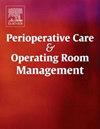Comparison of ultrasound-guided residual gastric volume measurement between diabetic patients with autonomic neuropathy and non-diabetic patients scheduled for elective surgery under general anesthesia
IF 1
Q2 Nursing
Perioperative Care and Operating Room Management
Pub Date : 2025-07-03
DOI:10.1016/j.pcorm.2025.100522
引用次数: 0
Abstract
Background
Pulmonary aspiration, the inhalation of gastric contents into the lungs, stands as one of the foremost causes of mortality and significant morbidity associated with general anaesthesia, highlighting its critical importance in perioperative care. Our study aims to compare gastric residual volume in patients with longstanding diabetes associated with autonomic neuropathy to that in non-diabetic patients. The study involved comparing ultrasound guided residual gastric volume measurements between diabetic and non-diabetic patients scheduled for elective surgery under general anaesthesia. Patients aged over 18 years, ASA grade I to II, with a history of diabetes for at least 8 years with diabetic autonomic neuropathy (diabetic group only) as Group A and non-`diabetics as Group B. Primary outcome was to measure Gastric residual volume between both the groups.
Results
There was a significant difference in age, systolic blood pressure (SBP), and oxygen saturation (SPO2) levels between diabetic and non-diabetic individuals. Significant differences of anteroposterior, cranio-caudal diameter, cross sectional area and mean gastric residual volume in both semi-sitting and right lateral decubitus position between the diabetic and non-diabetics was significant. Gastric residual volume (GRV) was higher in diabetics (-157.36 vs. -170.44), with a mean difference of 13.1 (p < 0.001) in semi-sitting position. Gastric residual volume (GRV) in right-lateral decubitus position showed a significant difference as well, with diabetics having a mean GRV of 16.71 compared to -11.03 in nondiabetics, a mean difference of 27.7 (p < 0.001)
Conclusion
Patients with long standing diabetes with autonomic neuropathy have more gastric residual volume and as well larger anteroposterior, cranio-caudal diameters with larger antral cross-sectional areas than non-diabetic individuals.
超声引导下自主神经病变糖尿病患者与择期手术非糖尿病患者胃残量测量的比较
肺误吸是指将胃内容物吸入肺部,是导致全身麻醉患者死亡和显著发病率的主要原因之一,因此在围手术期护理中具有重要意义。我们的研究旨在比较长期伴有自主神经病变的糖尿病患者与非糖尿病患者的胃残量。该研究涉及比较超声引导下糖尿病和非糖尿病患者在全身麻醉下择期手术的残胃体积测量。患者年龄大于18岁,ASA分级为I ~ II级,糖尿病病史至少8年并伴有糖尿病自主神经病变(仅为糖尿病组)为a组,非糖尿病患者为b组。主要观察指标为两组间胃残量测定。结果糖尿病患者与非糖尿病患者在年龄、收缩压(SBP)、血氧饱和度(SPO2)水平上存在显著差异。糖尿病患者与非糖尿病患者在半坐位和右侧侧卧位的前后位、颅尾径、横截面积和平均胃残余体积差异均有统计学意义。糖尿病患者胃残量(GRV)更高(-157.36 vs -170.44),平均差异为13.1 (p <;0.001)。右侧卧位胃残量(GRV)也有显著性差异,糖尿病患者的平均GRV为16.71,非糖尿病患者的平均GRV为-11.03,平均差27.7 (p <;0.001)结论与非糖尿病患者相比,长期糖尿病合并自主神经病变患者的胃残余体积、前后径、颅尾径和胃窦横截面积更大。
本文章由计算机程序翻译,如有差异,请以英文原文为准。
求助全文
约1分钟内获得全文
求助全文
来源期刊

Perioperative Care and Operating Room Management
Nursing-Medical and Surgical Nursing
CiteScore
1.30
自引率
0.00%
发文量
52
审稿时长
56 days
期刊介绍:
The objective of this new online journal is to serve as a multidisciplinary, peer-reviewed source of information related to the administrative, economic, operational, safety, and quality aspects of the ambulatory and in-patient operating room and interventional procedural processes. The journal will provide high-quality information and research findings on operational and system-based approaches to ensure safe, coordinated, and high-value periprocedural care. With the current focus on value in health care it is essential that there is a venue for researchers to publish articles on quality improvement process initiatives, process flow modeling, information management, efficient design, cost improvement, use of novel technologies, and management.
 求助内容:
求助内容: 应助结果提醒方式:
应助结果提醒方式:


